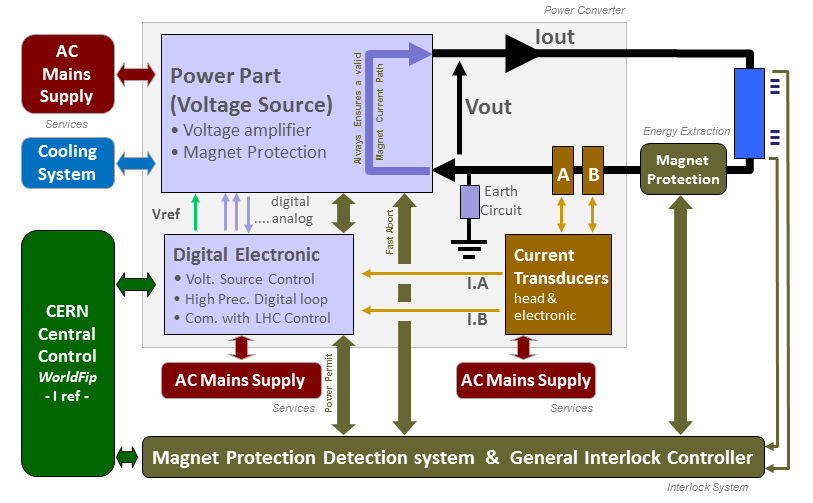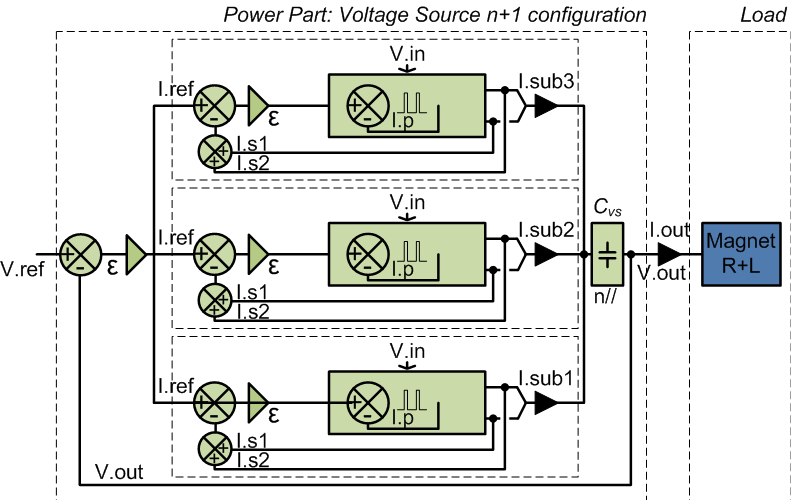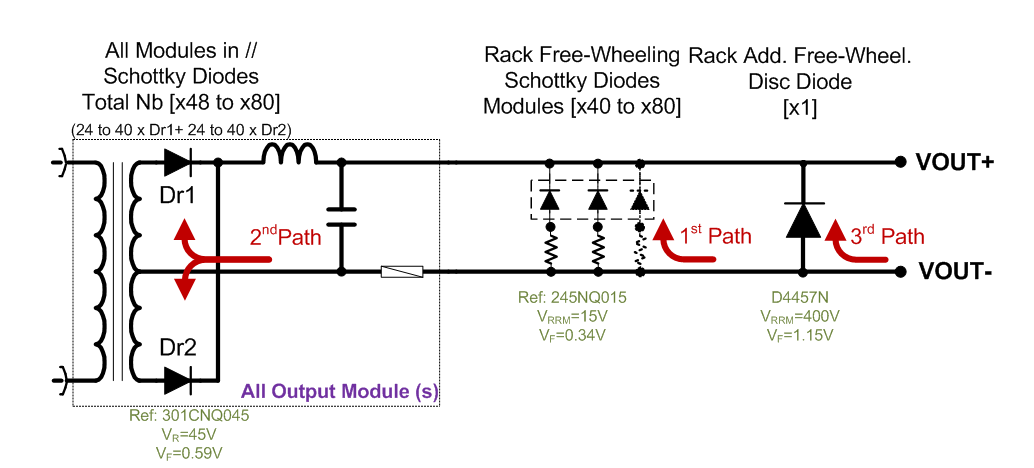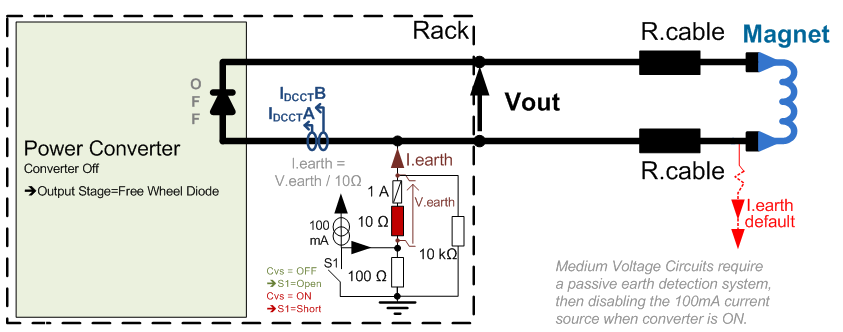|
RPHx / LHC4-6-8kA 08V |

|
 |
|
 |
|
 |
CERN
|
SY
|
SY-EPC
|
EDMS
|
PROJECTS
|
ODF
/
OOXML
|
|
CERN
|
SY
|
SY-EPC
|
EDMS
|
PROJECTS
|
ODF
/
OOXML
|

|
|
|
||||||||||||||||||||||||||||||||||||||||||||||||||||||||||||||||||||||||||||||||||||||||||||||||||||||||||||||||||||||||||||||||||||||||||||||||||||||||||||||||||||||||||||||||||||||||||||||||||||||||||||||||||||||||||||||||||||||||||||||||||||||||||||||
| Power In | 3 ~ 400V/90A to 100A |
| Power Out | [+4kA +6kA +8kA] +08V |
| Converter Type | 1 Quadrant |
| Control type | FGC2 / WorldFip |
| Current Accuracy | 5 ppm@ 30 mn |
| 10 ppm@ 24 h | |
| 70 ppm@ 1 year | |
| (1 ppm=4mA for a 4kA converter) |
 Design & Operation Responsibles
Design & Operation Responsibles
| 1st Intervention |
 Piquet SY-EPC LHC
Piquet SY-EPC LHC
|
| Responsibles: |
 Vincent BARBET
Vincent BARBET
|
 Ludovic CHARNAY
Ludovic CHARNAY
|
|
|
|
 Power Converter Architecture
Power Converter Architecture
This Power Converter is used in LHC Machine to power superconductive magnets. It is located in the LHC underground installation, close to the loads to limit cable losses in the underground installation.
Different parts were designed and produced separately, Power Converter being finally integrated in a housing rack, with 3 main parts:
- High Precision Current sensors: DCCTs, able to measure DC current at the required precision.
- Power Part: Power Rack and its removable Power Module
- A Digital Controller (FGC) using WorldFip bus in charge of:
- The high level control from and to the Cern Control Room
- The high precision digital current loop
- Collecting and reporting all status, faults, and measurements from all the different parts to the remote services, for diagnostic and operation purposes.

Power Converter simplified Architecture .ppt
 Power Part
Power Part
A high current high frequency (25 kHz) switch mode power converter, designed for powering of superconducting loads requiring only positive current and positive voltage control (1 quadrant). Constructed from a modular architecture composed of 2kA power modules, the system can be easily adapted to suit specific powering requirements. Used extensively in the LHC particle accelerator. The converter is water cooled, and is thus ideally suited to situations where air losses must be carefully managed. Designed for underground operation, extensive remote diagnostics have been foreseen to allow efficient monitoring and fault diagnostics without requiring being present locally.
Additionnal free wheeling diodes located in the Power Rack always provide a current path, independent of the converter status.
| Power In | 3 ~ 400V/90A to 100A |
| Power Out | [+4kA..+8kA +08V] (Brick: +2kA +08V) |
| Cooling type | Water Cooling (no forced air ventilation) |
| In/Out rack connection: DN25. | |
| Nominal Water Condition [+6kA +08V] → 18 l/min @ 2.5 bars of Differential Pressure Drop. * | |
| Nominal Water Condition [+8kA +08V] → 24 l/min @ 2.5 bars of Differential Pressure Drop. * | |
| * this nominal flow is a bit higher than original specification flow rate. | |
| Converter Weight | Full Equipped Rack 4kA ......... 1290 kg (Pwr Mods & elec. chassis + DCCTs incl.) |
| Full Equipped Rack 6kA ......... 1390 kg (Pwr Mods & elec. chassis + DCCTs included) | |
| Full Equipped Rack 8kA ......... 1640 kg (Pwr Mods & elec. chassis + DCCTs included) | |
| 4/6kA Converter Size | width: xxmm (4x19"-racks) |
| depth: 900mm | |
| height: xxmm(6U) | |
| 8kA Converter Size | width: xxmm (5x19"-racks) |
| depth: 900mm | |
| height: xxmm(6U) | |
| Power Module Weight | Input Power Module ................... 22 kg |
| Output Power Module ................ 37 kg | |
| Converter Control Electronic .... 12 kg | |
| Aux Power Module ....................... 5 kg | |
| Electronic Chassis ........................ 5 kg (Chassis + FGC + 1x PSU + 1 AC-DC) | |
| DCCT Electronic Chassis ............. 5 kg | |
| DCCT Head ................................ 60 kg (4-6-8kA Head) | |
| Power Module(s) Size | width: xxmm (19"-rack-compatible) |
| depth: xxmm | |
| height: xxmm(6U) |
Power Converter is normally assembled using a n+1 Power Bricks [+2kA +08V] to provide active redundancy in case of one subconverter is lost. For example, a [+8kA +08V] is composed of 5x [+2kA +08V] Power Brick, working as current source being controlled by a Voltage Source main control.

/ Topology
[2kA 08V] Sub-Converter simplified Architecture / Topology .vsd
Power Brick is actually a high frequency current source (7-8kHz) controlled by a 1kHz bandwidth voltage loop. One can notice that Power Brick is actually a current cource in its structure, even if voltage source capacitors are located in this block for mechanical reasons. Representation below gives a symbolic structure of the power converter, clarifying the cascade loops. ( Is1 & Is2 are actually assumed to be representative and equal to the current of each power transformer secondaries). The multiplication of rectifier stages in each output module gives the following advantages: easier design of magnetic parts, lower rating fuse (lower losses) to protect whole Power Converter being short-circuited by a faulty secondary (fuse would immediately blow in case one of the schottky dies, giving the possibility to the whole power converter to reconfigure the current level in other current sources to maintain required voltage level).

[4-6-8kA 08V] Voltage Source simplified Architecture / Topology .vsd
Typical Curves
| Sub-Converter Output Module Curves | |
| Output Power Rectifier Voltage V0x .txt | [500A 0.5V] Zoom , [1kA 1.0V] Zoom , [1.5kA 1.5V] Zoom |
| [500A 2.7V] Zoom , [1kA 5.3V] Zoom , [1.5kA 8.0V] Zoom | |
| Unknown Conditions with higher spikes... | [80A xV], [500A xV], [1500A xV] |
| Output Power Rectifier Current V0x .txt, 1.jpg, 2.jpg | [2000A xV] Zoom , |
Sub-Converter Curves |
|
| Current source bandwidth I.ssub(4x-scaled) / I.refsub | Bandwidth Step-Resp. Sine-Resp. 1kApp |
Converter Curves |
|
| VOUT Ripple vs IOUT (5x sub-cvs) .txt, .jpg | 200A I pp-FFT / V | 1kA I pp-FFT / V | 2kA I pp-FFT / V |
| 6kA I pp-FFT / V | |
| Output Voltage Large Signal Limitations | [1Vpp, 6Vpp]Sq. - [1Vpp, 8Vpp]Sine - [1Vpp, 8Vpp]Tr. |
| EMC AC Side Perturbations | |
| AC Network Events | High I.out 3Ph Loss Event |
| Phase Loss SOA: 1ph - 3ph | |
| Voltage source bandwidth Vout/Vref | Bandwidth Step-Response |
| Voltage Source Efficiency vs Output Power | Efficiency Graph |
 Control Part
Control Part
Control & regulation principles are summarized in a detailled schematics representating only the part involved in the output current regulation scheme.

Regulation Control simplified schematic .vsd
High precision current control loop is managed by the digital controller called FGC (Function Generator Controller). This unit includes a high precision Sigma Delta Analog to Digital Converter which digitalize the analog current measurement coming from 2 DCCTs (DC current Transducer). Precision is then directly relying on sensor precision: DCCT, the ADCs, and the algorithm being used for the regulation loop. Voltage source is then used as a power amplifier, powering the load through a high bandwidth voltage loop (>500Hz).
 Magnet Protection
Magnet Protection
Power Converter is part of magnet protection scheme, even if not directly fully responsible of the monitoring and diagnostic of the superconductive magnet status. Dedicated systems QPS (Quench Protection System) + PIC (Power Interlock Controller) can interlock Power Converter if magnet safety requires it.
Power Converter is then expected to:
- Always ensure that external protection system can stop the Power Converter through a safe signal called Fast Abort. This redundant signal uses 2 paths to interlock and stop the converter and its redundancy is checked each time it acts. It directly acts on AC Contactor bobbin, ensuring its opening as required.
- Stop powering the load in safe way (handling the magnet energy even when stopping, through dedicated system called Free Wheeling Diode Safe Paths). This passive system based on different paths using several free-wheeling diodes in the rack provide a safe discharge path for magnet current (energy).
- Monitor Earth current of the total circuit: converter + load (magnet and its DC cables), and take the right action if threshold reached.
- Free Wheeling Diode Safe Paths
The system is based on 3 different paths provided by Free-Wheeling Diodes providing a safe path for magnet current. The number of Free-Wheeling diodes (x40..x80, 20x per cards) to be considered depends on the converter type (see chapter Machine Installation below). Only one unique Additionnal Free-Wheeling Diode is always present as a last chance 3rd path.

Crowbar System simplified schematic .vsd
- Earth System
The circuit injects a 100 mA DC current on a grounded resistive branch, resulting in a common mode voltage at the output circuit easing the earthing fault detection. Output circuit Common mode voltage is, without any earth fault, around 10V (=100 mA x 100 Ohms), and is not relying on load operation, making possible to detect an earth fault even with converter being OFF. (OFF, not condamned).
If an earth fault occurs on the output circuit, a faulty current will be deviated from the initial path back to earth by using the shunt 10 Ohms resistor path (monitored for detecting this fault).
Overcurrent protection is achieved through a 1A-100V fast fuse in series in the path provided for the earthing fault current.

Earthing System simplified schematic .vsd
 Power Converter Components .vsd
Power Converter Components .vsd

A power converter is actually a sum of different equipments under several different sections in the SY-EPC group. The modularity is a key factor for easier maintenance with regards to LHC tunnel access conditions.
Power Converter Rack
- Power Converter Rack
- Voltage Source Unit
- FGC2 Fan tray unit
- 2x Current sensors: DCCTs Heads
- 2x Current sensors: DCCTs Electronics
- Electronic Chassis (Ref: HCRFEFA - Type 5) .edms
- Digital Controller: FGC2
- AC/DC Power Module
- PSU FGC Tri-volt
- Calibration Rack (Inner Triplet Only)
- 2x Current sensors: DCCTs Electronics
- Sigma Delta 22 bits ADC
 Magnet Types
Magnet Types
| Fonction | Inner-Triplet for Squeezing(RQX and RTQX2) |
| Insertion Quadrupole (RQ4 to RQ10) | |
| Insertion Dipole (RD1 to RD4) | |
| Solenoide (ATLAS) | |
| Extraction East zone (SMH57 and SMH61) |
 Machine Installation .xls
Machine Installation .xls
| Use | LHC 188 Pc |
| ATLAS Solenoide 1 Pc | |
| PS 2 Pc | |
| LHC Use | 189 Power Converters (20+1 RPHF-Type, 36 RPHH-Type, 132 RPHG-Type) |
| Radiation Safe Locations (123) | UA23 (18), UA27 (18), UA43 (14), UA47 (14),
UA63 (04), UA67 (04),UA83 (18), UA87 (18) UJ63 (06), UJ67 (06), USC55 (02), USA15 (01) |
| Radiation Exposed Locations (066) | RR13 (15), RR17 (15), RR53 (15), RR57 (15)
UJ14 (02), UJ16 (02), UJ56 (02) |
| Type | Equipement variations | ||||||||
|---|---|---|---|---|---|---|---|---|---|
| Sub-Conv. [nb] |
I.nom [kA] |
I.max [kA] |
I.DCCT.Rated [kA] |
V.max [V] |
ADC Type [bits] |
FWD Cards [nb] |
FWD Diode [Ref:245NQ15] |
FWD I.Rated [kA] |
|
| RPHH | 3 | 4 | 6 | 4 | 8 | 16 | 2 | 40 | 6 |
| RPHHB | 3 | 4 | 6 | 5 | 8 | 16 | 2 | 40 | 6 |
| RPHGA | 4 | 6 | 8 | 6 | 8 | 16 | 2 | 40 | 6 |
| RPHGB | 4 | 6 | 8 | 5 | 8 | 16 | 2 | 40 | 6 |
| RPHGC | 4 | 6 | 8 | 5 | 8 | 22 | 4 | 80 | 12 |
| RPHF | 5 | 8 | 10 | 7 | 8 | 16 | 3 | 60 | 9 |
| RPHFA | 5 | 8 | 10 | 13 | 8 | 16 | 3 | 60 | 9 |
| RPHFC | 5 | 8 | 10 | 7 | 8 | 22 | 3 | 60 | 9 |
| RPHFD | 5 | 8 | 10 | 6 | 8 | 16 | 3 | 60 | 9 |
Overview of the different converter types in LHC machine .xls
 Production Contract & Contact History
Production Contract & Contact History
| Developped | KEMPOWER |
| 2001-2003 | |
| Manufactured | Lahti, Finland |
| KEMPOWER | |
| Production | 203 Pc |
| CERN Contact |
 David NISBET
David NISBET
|
 Vincent BARBET
Vincent BARBET
|
 Converter Circuit Names
Converter Circuit Names
| TOP | CHARTE | HTML | CSS | Ver : 04-09-2023 17:19:20 | Webmaster : Michel GEORGES. |
